Garden gnomes are among the most common garden decorations in the West. We encounter them nonchalantly scattered across the lawns, in the gardens and yards from North America to Greece.
Gnomes are shaped as ornamental figurines of various sizes depicting males of a small, mythological humanoid race that lives underground.
You are watching: History Of Garden Gnomes – Origin, Meaning, Uses & Debate
Their history goes back to ancient Roman mythology, covering centuries of western European tradition.
Also, from the very beginning, they were considered to be good luck charms.
Let’s take a peek into the long and exciting history of garden gnomes – from ancient Rome to the modern traveling gnomes.
Garden Gnome Meaning
The etymology of the word “gnome” is not completely clear. Paracelsus, named elemental earth beings pigmaei or gnomi to, possibly from the Greek word “genomos” meaning “earth-dweller.”
It is less likely that “gnomus” was derived from the similar-sounding Greek word gnosis, meaning “knowledge.”
Petite Gnome In Ancient Rome

The earliest appearance of garden gnome-like statues was in ancient Rome. Their garden forerunners were statues that represented the Roman gods.
The most common among them was the god Priapus, a minor fertility deity who originally came from Greek mythology. He was a protector of livestock, planting, and gardening, which was symbolized by the depiction of his… Well, permanent erection.
The primary function of these statues was to protect the gardens from evil spirits, as well as to ensure a successful harvest.
Early Modern Period – From Gobbi To Lampy

In the Renaissance era, the grotesque potential of those statues was expanded following the general spirit of the age.
Swiss alchemist Paracelsus was the first one who described them as creatures with magical power. According to him, gnomes were one of the four elementals or nature spirits (invisible beings that existed among humans), belonging to the earth. They would come out at night to help plants grow. During this period, gnomes were pleonastically called “Grotesques” and thus were made to be ugly petite hunchbacks, painted in bright colors and usually named by the Italian word “Gobbi.”
Garden gnomes became widely popular as home ornaments by the beginning of the 18th century, but mostly for wealthy families only.
The popularity of gnomes persisted thanks to the folklore, myths, and stories from around the world, such as German fairy tales, where gnomes and dwarfs were present largely as little creatures with mythical power helping humans in farming. They were a good example of how folklore and mythology influenced the history of everyday life.
The First Garden Gnome
It is believed that the very first contemporary-looking garden gnome (with the iconic red hat), was made in Germany by sculptor Phillip Griebel. Soon, the fashion had spread across Europe, from England to Poland, and Griebel concentrated his entire manufacturing around producing garden gnomes.
In the 19th century, Sir Charles Isham brought several of Griebel’s gnomes to England, introducing them to the new market. He is credited with beginning the tradition of garden gnomes in the United Kingdom, where they were nicknamed “Lampy.” One replica is still preserved and displayed in Lamport Hall, the Isham family residence in Northamptonshire.
Consequently, the manufacture of gnomes became very common in Germany, with different businesses emerging across the country, although Griebel remained famous among them, and still exists as a family business in Germany.
The 20th Century – Intermittent Rise And Fall Of Gnome
The beginning of the modern era in Europe brought troubling and uncertain times, which culminated with World War I and World War II. Their consequences changed the course of modern history, as well as leisure time habits. Unsurprisingly, the popularity of garden gnomes was in decline during this period.
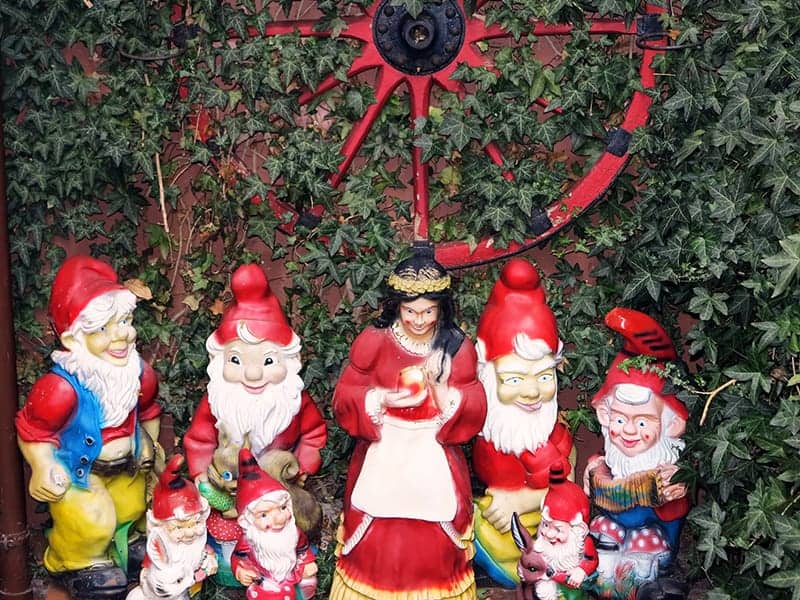
Read more : Garden of Eden— Where was the Garden of Eden located?
However, thanks to popular culture, garden gnomes have returned to homes and gardens in Europe once again. In 1937, Walt Disney Productions released “Snow White and the Seven Dwarfs,” as an animated musical fantasy movie. Decades later, in 1989, the movie was recognized for its cultural and historical significance, thus being preserved in the National Film Registry. Part of its cultural influence lay in restoring the glory of garden gnomes, whose physical similarity with dwarves was more than obvious.
Since the 1970s, the mass-production of garden gnomes has replaced handicrafts. The variety of materials was greater than before, and many gnomes were now made of plastic. This type of production led to lower quality compared to the handmade gnomes.
However, such manufacture made garden gnomes more affordable and thus available to a wider market. However, they have lost the artistic value they once had. They traveled a long road from exclusive decoration for the wealthy and powerful, to the ornament frequently displayed in middle and working-class gardens.
The Traveling Gnome Prank
The “Traveling gnome” is a game that dates back to the 1970s. It started when one traveler photographed two of his gnomes during his travel around Antarctica.
It became widely popular during the 1990s, when a community in France named the Garden Gnome Liberation Front made a prank out of it, stealing gnomes and taking them traveling.
The concept was to give the gnomes freedom they were believed to want.
Thieves usually sent photographs of the gnomes to the owners, showing them that their minions were safe and sound, in their newly gained freedom and independence. This community dedicated itself to the purpose of “freeing garden gnomes.”
Over time, the prank became popular on a global scale, with many cases of stolen traveling garden gnomes and their photographs in front of famous landmarks worldwide. Instead of some random backyard somewhere in the UK or Germany, the “traveling gnomes” could be seen in front of London’s Big Ben and Paris’ Eiffel Tower. Such cases often took part in news, both in North America and Europe.
One of the latest was telling a story of a Canadian lady, whose garden gnome was missing for eight months. Finally, the gnome was returned to her, along with his travel diary. This book, containing stories and pictures of his travels all the way from his Canadian home in Vancouver Island to the Baja Peninsula in Mexico.
Such hard work proved the commitment of pranksters and the practitioners of the Traveling Gnome game around the world.
In 2001, the traveling garden gnome theme became the basis of the famous French movie “Amélie.”
Gnomes’ Red Cap
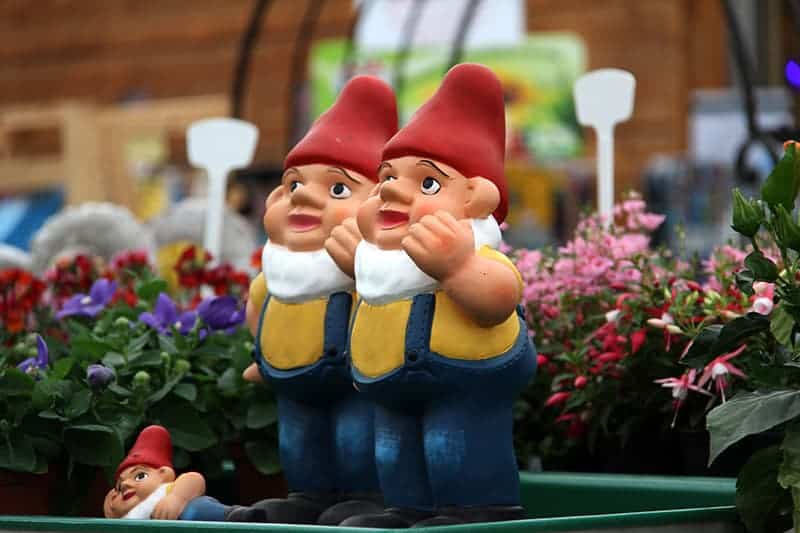
The garden gnome trademark has always been the so-called Phrygian cap. It’s a soft, conical hat, usually painted bright red. It originates from the Hellenistic period, as it is preserved in depictions in Greek vase-painting and sculpture.
Nowadays, the hat is known as a Gnome and has got a brand new meaning. In revolutionary France, the Phrygian-style cap became a symbol of revolt against the establishment, called “Bonnet rouge.” It was first documented in 1870.
This is why the national symbol of France, Marianne, is always depicted wearing a red Phrygian cap. Since Marianne is a personification of liberty and equality, it is easy to bring together such tradition with the aforementioned Traveling Gnome prank, whose aim was to free gnomes from their garden prisons. No wonder this joke has bloomed in France, the very cradle of the modern concept of liberty.
Making Of Garden Gnomes
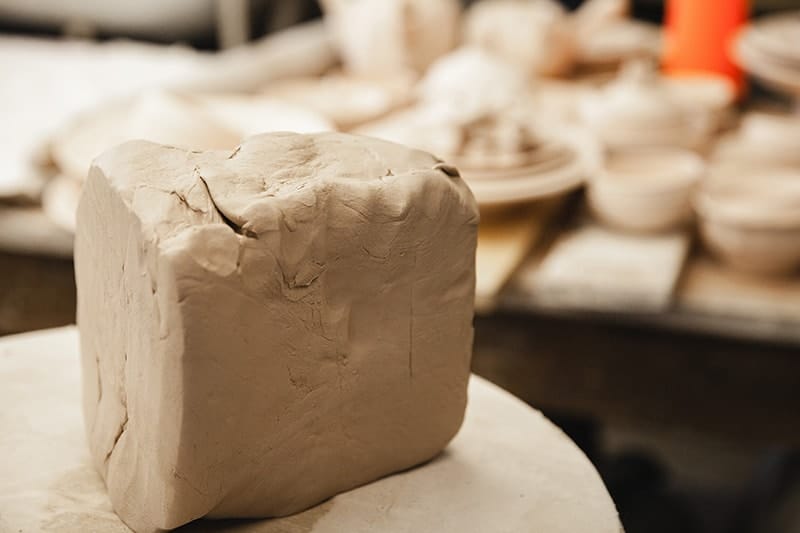
Garden gnomes are typically shaped in the human form as small statues. Through centuries, they have been traditionally handmade from terracotta clay, using a mold. Once its shape got firm, the gnome could be removed from the mold.
The next step was drying and heating in a kiln, a special type of oven used for firing pottery until it got hard. The final step included painting and brushing the gnome in bright colors.
With the development of technology, the manufacturers started to use some other materials, such as resins and, more lately plastic.
Today, there are many tutorials on how to make a garden gnome at home available online.
Types Of Garden Gnomes
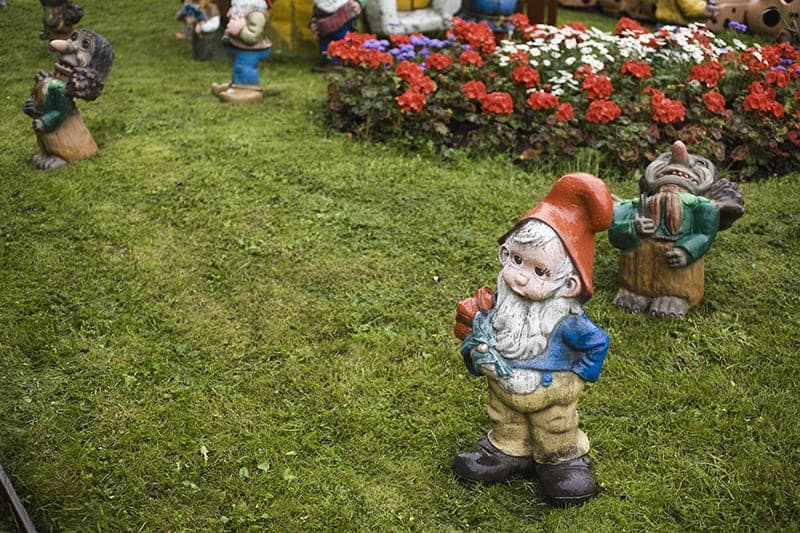
The details of the appearance of garden gnomes have gone through many changes over the centuries.
The majority of them are shaped as males with long, white beards and pipes. Female gnomes were rather rare and usually without the beard, but having a simple dress, and the same pointed hat as the male ones. It is why they can look somewhat like witches. They can also be displayed as a gnome family, consisted of a mother, father, and children.
Since they were supposed to help with sweeping and planting, according to the legend, traditional garden gnomes were usually depicted holding garden tools such as shovels or wheelbarrows. More modern gnomes are rather represented during their spare time – reading, fishing or napping.
Uses Of Gnomes In The Garden
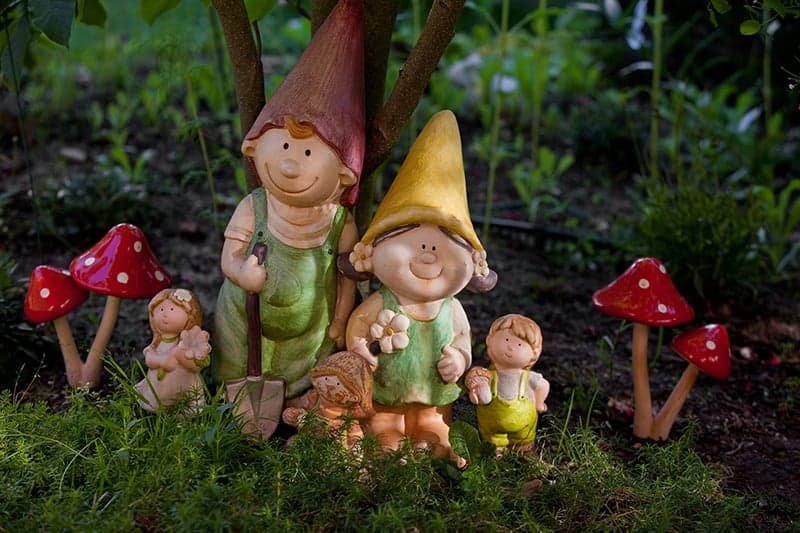
There are various uses of gnomes in gardening. They can be put on different places around the garden or around the house: hidden in your backyard, in the flower beds or bushes.
Gnomes will also do well as decoration near a water feature – a pond or a fountain; they can reflect in the water. They can also be incorporated in solar lighting installations.
Also, a garden gnome can be placed somewhere around the front yard, for example at the front steps, where he can serve as a centerpiece. In the context of front yards, gnomes can make dull lawn patches more fun and interesting.
Gnomes, From Gardening To Popular Culture
As I mentioned before, garden gnomes became a significant part of popular culture nowadays, having appeared in many movies, commercials, and video games. After gaining popularity in Disney’s “Snow White and Seven Dwarfs,” gnomes played roles in several more movies and books.
From a popular open-source desktop environment for Unix-like operating systems named GNOME to the marketing use of gnomes by the Social Democratic Party of Austria, gnome-like creatures remained the popular determinant of western culture. Not to mention famous novels written by J.R.R. Tolkien, C.S. Lewis, J.K. Rowling, and Terry Pratchett.
Travelocity, an American online travel agency launched a series of viral marketing advertisements called “Where is my Gnome?” Its mascot, a very well-known garden gnome with black boots and red hat, became known as “the Roaming Gnome.” Travelocity also created an official profile for the Roaming Gnome on Instagram and Twitter. Fans can follow his international escapades regularly, watching photographs of a cute gnome eating pizza in Italy, traveling on a plane or striking a pose in front of the Golden Gate Bridge in San Francisco.
One short commercial video with the garden gnomes made by Travelocity
The cover of the famous George Harrison’s solo album “All Things Must Pass” contains gnomes that belonged to Sir Frank Crisp at Friar Park in Oxfordshire, another British gnome collector from the late 19th century.
Onto the big screen, “Gnomeo and Juliet” and its sequel “Sherlock Gnomes,” are British-American production animated movies. The original was inspired by Shakespeare’s tragedy “Romeo and Juliet,” using its plot to tell a story in which gnomes are the main characters, reuniting two families, that used to be enemies. Art can use different traditions very well, and this movie is a good case in point.
One of the contemporary marks of garden gnomes is the process of their personification. Sometimes, they are given a specific voice and personality, to serve some artistic or comical purpose. One of the more famous examples is the Gnome Chomsky, made after Noam Chomsky, an American philosopher, linguist, and political activist, and he could be ordered online in several sizes.
There are also several gnome festivals around the world, conducted in many countries from the United States to Australia, celebrating those mythical creatures.
Garden Gnome Aesthetical Debate
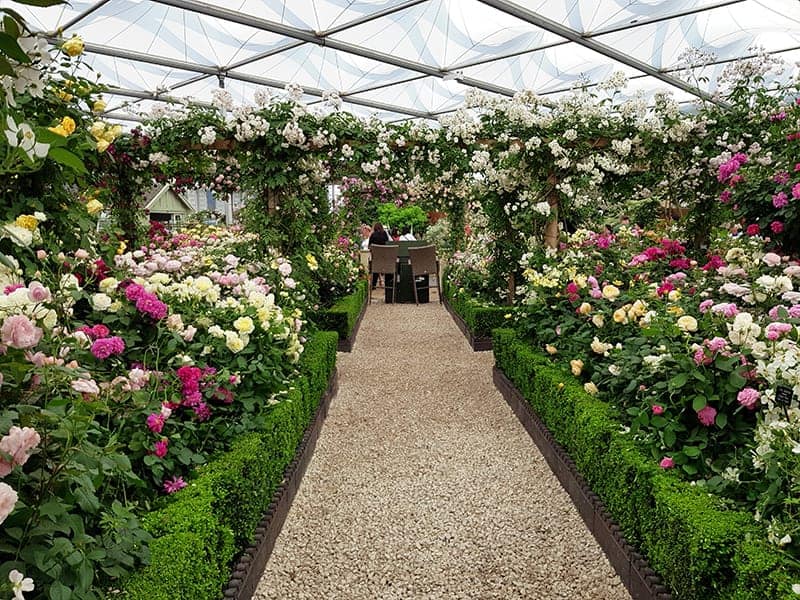
The fame always comes with a flipside. It is certain that garden gnomes have a love-hate relationship with the public. A notorious example of that is the Chelsea Flower Show.
After years of appeals and protests, in 2013 the Royal Horticultural Society of Britain lifted a ban on using garden gnomes at the Chelsea Flower Show, to the joy of gnome lovers and to the horror of those who see the garden gnomes as the ultimate kitsch. The latter group has often been labeled “garden snobs” and “gnomophobes.”
Since the Chelsea Flower Show is the most influential garden-related event in a country with a long gardening tradition, such a debate was expected.
Conclusion
From the very beginning of Western civilization, gardening was an important element of everyday life and relaxation. Garden gnomes have been given a big role in it. Related specifically to the gardening tradition, they remained the most common stereotype of home gardens across the world. Garden gnomes are a sweet cliché.
On the other hand, seen as kindred spirits and human little helpers, deeply rooted in our tradition and mythology, they became an inevitable part of every childhood. The stories they portray maintain the continuity of the culture, even beyond gardening.
Source: https://gardencourte.com
Categories: Garden news

